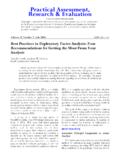Transcription of 10 Steps to a Successful Digital Asset Management ...
1 10 Steps to a Successful Digital Asset Management ImplementationStrategies and Best PracticesImplementing and deploying enterprise solutions across the organization can be complex, involving many strategic and technical decisions. This paper discusses lessons learned and best practices for a Successful implementation and adoption of Digital Asset Management (DAM) in your enterprise. by SrIkAnth rAghAvAn, DIrector, ProDuct MAnAgeMentmay Identify the right Product for Your Get Leadership Build a Project Implement in Phases ..55. Use the right Implementation Understand the Vendor Roadmap and Interact Establish Governance Get Users on Integrate DAM with Internal Establish a DAM community.
2 8 WHITE PAPERENTERPRISE INFORMATION MANAGEMENT310 Steps to a Successful Digital Asset Management System ImplementationIntroductionRich media and Digital content is pervasive in organizations and continues to grow expo-nentially. Coupled with today s challenging economic environment, enterprises are focusing on operational excellence, cost-cutting, and Return On Investment (ROI) to help maintain profitability. Digital Asset Management (DAM) is rapidly evolving from a departmental tool for archive and library Management to an enterprise-wide solution for workflow and collaboration. Industry-leading organizations consider DAM solutions as key strategic components of a broader creative and intellectual property initiative that is capable of.
3 N Becoming a revenue stream by leveraging Digital assets across multiple distribution and communication channelsn Reducing total cost of ownership by reusing and repurposing rich media assets n Delivering greater operational efficiency with easy access and interaction to information and content n Achieving operational effectiveness through collaboration, workflow, and process automation n Meeting and maintaining compliance and legal standards with audit trails and reportsExplosive growth in the DAM marketplace and many different products, platforms, and capa-bilities challenge organizations knowledge of what will work best and how to proactively align programs with the company s strategy for managing Digital content, branding, video, and marketing content.
4 It s not just a list of features and functions. Considerations of imple-mentation, extensibility, vendor strategy, and commitment are important when evaluating which particular product or solutions will be the best for your and deploying enterprise solutions for internal and external users is a complex art and involves many strategic and technical decisions. Organizations make significant investments to ensure the solution they deploy meets the needs of their business community and stakeholders. These 10 Steps are a collection of lessons learned from the many different implementations of OpenText Media Management for a variety of customers and industries.
5 It provides guidelines to ensure a smooth, Successful implementation and greater user adoption of DAM in your enterprise. This white paper will provide you with guidelines to ensure a smooth, Successful implementation and greater user adoption of DAM in your PAPERENTERPRISE INFORMATION MANAGEMENT410 Steps to a Successful Digital Asset Management System Implementation1. Identify the right Product for your organizationSoftware-as-a-Service (SaaS) or enterprise. There is an increasing trend to cloud-based systems as solutions are offered by some DAM vendors. In addition, open source solutions from consultants and system integrators offer custom products and implementations to customers.
6 Deciding to go with these products versus an enterprise solution depends on many factors. One key area is the organization s available infrastructure and IT Management capabilities and the inclination to outsource such operations outside the company. It also depends on the storage and usage needs of the DAM system, the network capacity, and the distribution of users. The SaaS model, cloud-based storage, and security of content are maturing. The relatively low upfront investment, faster implementation cycle, and outsourced IT should be compared to the ability to customize and extend the system based on the organization s strategic or on-premise.
7 Again, this decision is primarily based on the internal IT capabilities of the organization. Some companies have a fully functional IT organization and infrastruc-ture and prefer to own their systems, while others like to delegate the Management of the infrastructure and products to external sources. Customers should evaluate both options and decide based on their use cases and internal IT policies and It rules, policies, and constraints. Many organizations have strict policies around their IT infrastructure, including access to external sources, firewalls, and data trans-fer rules. The project team should understand the IT policies so that the system can be built to adhere to internal standards.
8 For example, companies have very strict policies concerning external user access to File Transfer Protocol (FTP) sites or to provide an unsecured HTTP access to internal applications, typically requiring users to be authenticated via a VPN or a Portal. While designing the system, such policies should be considered in order to eliminate issues in the get Leadership buy-InLeadership buy-in. Successful projects require leadership buy-in and an executive sponsor. This is key to getting the project up and running and to sustain future investment in main-taining a viable and effective DAM solution. Having the support and active participation of the executive team is necessary in getting the essential budget, resolving interdepartmental issues, and providing a sense of reassurance to the project team.
9 It elevates the visibility of the project in the organization, impacting adoption and furthering the success of the project. create a business plan. A formal business plan outlines what the DAM system will accom-plish its value to the organization quantifies it, and then justifies the investment. The start-ing point is documenting the way things are done now and what it costs in terms of time, effort, and resources. With this as a baseline, you can project any cost-savings in time, effort, and resources when the DAM system is deployed. A business plan maps out where you re at, where you re going, and the plan to get there, and serves as a blueprint for the entire key to Successful projects are leadership buy-in and an executive PAPERENTERPRISE INFORMATION MANAGEMENT510 Steps to a Successful Digital Asset Management System Implementation3.
10 Build a Project teamInclude business, It, and users. A well-managed DAM implementation typically involves three main groups business, IT, and user community. This ensures that all of them are in lock step agreement on what is being built and can also resolve issues as they surface. Building a system in isolation will result in poor adoption by the users (a sense of thrusting it down their throats) and eventually will lead to failure of the a champion of the DAM cause. Implementing a DAM system requires a culture change in an organization. Change Management and adoption is usually the greatest obsta-cle in a Successful DAM project.








